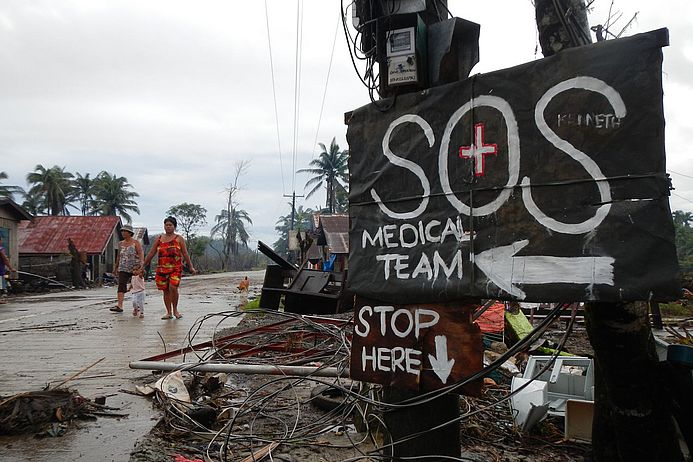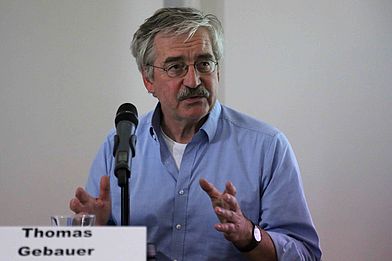1.
In recent decades the environment for aid has changed dramatically in certain respects. Disasters and crises have increased in both number and intensity. We now talk about so-called protracted crises, whose effects are initially delayed, but then generally extend over a longer period. Conventional development policy action is increasingly being questioned under these circumstances.
2.
In addition to natural disasters such as earthquakes and floods, a number of man-made disasters have emerged whose causes are rooted in climate change, increasing social inequality, collapse of states and/or wars. It is not unusual for multiple crises to evolve in such a situation.
One example of how an isolated crisis can escalate into a cluster of multiple crises is an outbreak of Ebola, which ultimately affects all spheres of society – the educational sector, food safety, economic power, the social network. Crisis clusters like this are increasingly emerging.
The flight and migration of millions of people is not the least expression and consequence of the increasing pattern of multiple crises.
3.
Globalisation has undoubtedly brought the world closer together, but it also appears more divided than ever. The global North, with its economic, technological and cultural dominance, stands in contrast to growing zones of misery, humiliation and violence in the global South. This has long since spread into the suburbs of North America and Europe.
There are two contrary movements which have determined globalisation to date: first, the world has become integrated into a global system, which gives rise for the first time to the possibility of global social relationships, and second, large parts of the world population who there seems to be no place for in this system have been socially excluded. They have become “redundant people” – people who are no longer needed in the global economic context. Many of them are eking out an existence in permanent camps.
4.
The dramatic growth of inequality is by no means accidental – it is the direct consequence of a radical free market reorganisation of the world and the shrinkage of labour markets as a result of the introduction of new technologies. The promise that there would be some crumbs from this for the poor has proved deceptive: instead of a trickle down effect, we have seen the opposite, redistribution from the bottom to the top – the rich became richer, the poor poorer. According to Oxfam, there are eight individuals today who have as much wealth as the lower 3.5 billion of the world population together.
“In terms of global society, the megatheme for the next 30 years will no longer be ecology or sustainable development, but inequality,” the German sociologist Heinz Bude wrote recently in a study by the Bertelsmann Foundation. Even the Davos World Economic Forum had to admit at the beginning of the year that the risk of social disorder has increased drastically in the course of globalisation.
5.
The German Federal Government report on German humanitarian foreign aid published in late 2015 leaves no room for doubt: misery in the world has long since taken on a scale which can no longer be mitigated by aid. Today, the need for aid dramatically exceeds the funds available worldwide. Even the major UN aid organisations are now overwhelmed. The unchecked pace of crisis in recent years has burst the boundaries of the international humanitarian system. “We are at a turning point in history,” as Stephen O’Brien, UN emergency aid coordinator, recently said in connection with the famine in East Africa and Yemen, which is threatening up to 20 million people.
6.
Given all this, it is not surprising that international humanitarian aid is currently going through a paradigm shift. Going beyond the model of responding to sudden disasters and crises, instruments of humanitarian aid are increasingly being planned and deployed in anticipation. Responsible humanitarian aid is not just reactive but proactive. Risk analysis and risk management are needed just as much as the provision of aid in the face of acute need. Direct emergency aid can only be one element in humanitarian aid. Anticipatory strategic aid must consider other dimensions in addition to direct emergency aid, including structural prevention of crises, systematic promotion of local preventive and coping competencies and strengthening public and social institutions.
7.
However, the concept of resilience is proving a two-edged sword here. While it makes sense to assist people in building up their own coping capacities in advance of disasters, it becomes a problem if efforts to increase resilience are used to justify abandoning attempts to deal with the causes of crises, namely structural violence and the ongoing social and ecological destruction.
Trend researcher Matthias Horx, one of the puppets of the neoliberal transformation of relationships: “In the next few years, resilience will replace the wonderful slogan of sustainability, behind which stands an old illusion of harmony, whereas in fact living and evolutionary systems are always functioning at the boundary of chaos.” What Horx dismisses as an “illusion of harmony” is the normative dimension of the concept of sustainability. It implies values which political, economic and technological decisions need to align with. A normative concept like this is absent from the idea of resilience, which is no longer a question of social ideals, but merely of the question how people and systems can protect themselves against disruption, a world, in fact, which has come off the rails – in other words, how they can train for disaster.
8.
Where people are constantly exposed to crisis-like living conditions, the need for help also changes, as is evident in e.g. medical aid. Because people with an average standard of living are also becoming increasingly affected by crises, aid has to go beyond treating acute infectious diseases to cover chronic and non-infectious diseases such as diabetes, cardiovascular illnesses etc.
9.
Particularly in a context of armed conflict, aid today is very much more complicated. First, there is the growth in the percentage of internal displaced persons (compared to those fleeing from the country), who are generally more difficult to reach (see Syria). In addition, there are growing security risks to aid workers. Increasingly, humanitarian facilities are becoming a target for military attacks. Where parties to conflicts are prepared to engage in terrorist activities, appropriate humanitarian aid becomes increasingly impossible. In situations like these, care for victims can only be organised with a high degree of risk to aid workers, and often only on a very local and flexible basis.
10.
Where crisis situations take root, local rulers lose popular support. To avoid the resulting loss of legitimacy, many governments try to limit the scope for action of independent and critical civil society actors pushing for accountability (shrinking spaces). Measures range from restrictive NGO and media laws and bureaucratic requirements through censorship and smear campaigns to open repression by security forces. These impact not only local partners but also their international supporters.
11.
It is no longer sufficient to reinterpret aid, it is a question of overcoming it.


